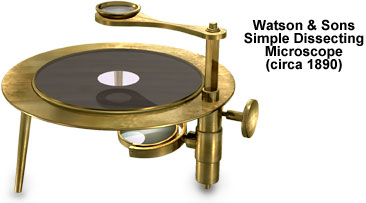Watson & Sons Dissecting Microscope
Three legs support a brass ring that supports the circular glass stage of the late-nineteenth-century Watson & Sons simple dissecting microscope. The instrument illustrated below is based on a photograph and description by Julian Holland, published in his description of the Macleay Museum's microscope collection.

William Watson and one of his sons established a highly successful microscope-fabricating firm in London in 1837, and by 1891, after a second son joined the business, they had crafted more than 3,000 precision microscopes. The firm continued for almost another century before merging with Philips in 1967. Engraved on the lacquered, brass ring of the microscope featured here is "Watson & Sons, 2306. 313 High Holborn, London." The "2306" refers to the serial number of the item, which indicates a manufacturing date before 1891.
The circular stage of simple dissecting microscope is blackened underneath, but retains a 32-millimeter wide clear center for transmitted light microscopy. One of the three legs of the instrument supports the substage, concave mirror and the racked pillar support for the lens arm. The microscope is equipped with two drop-in lenses, and focus of specimen can be accomplished by turning a large brass, knurled pinion head, which moves the eyepiece lens up and down.
BACK TO NINETEENTH CENTURY MICROSCOPES
